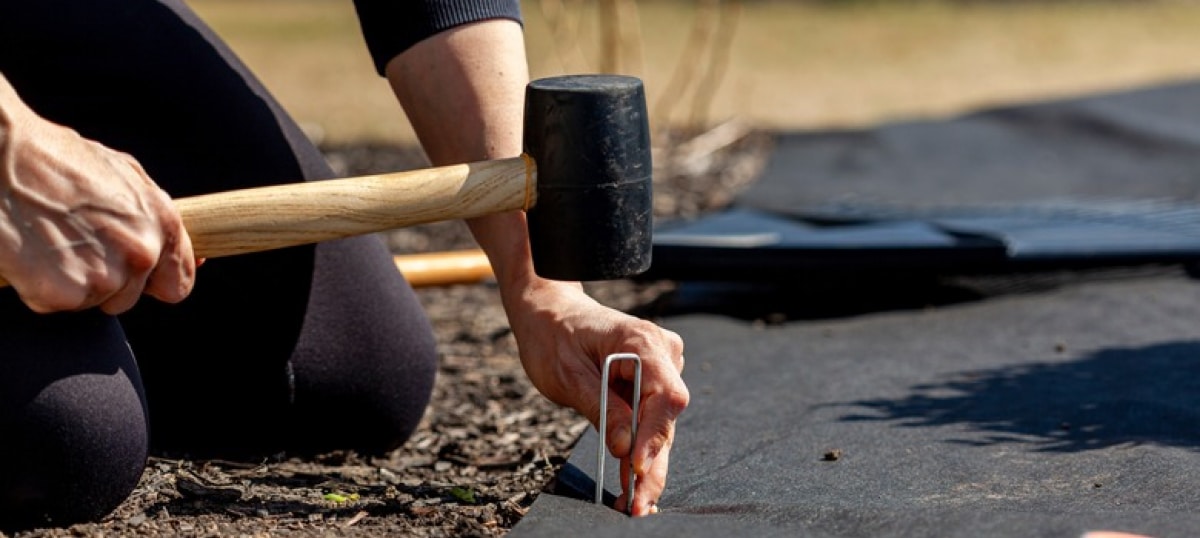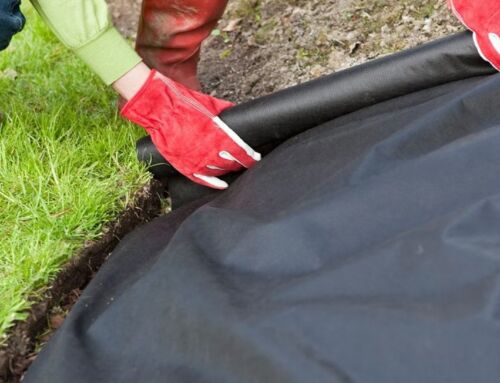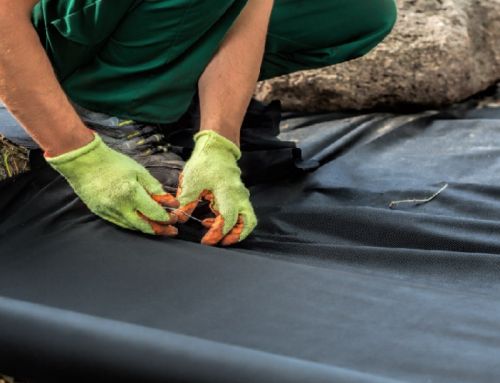Creating a vibrant garden space is not just about planting your favourite flowers and shrubs; it’s about ensuring they thrive in a well-defined, weed-free environment.
Installing landscape fabric around your garden’s edges has become an essential step for Sydney garden enthusiasts and homeowners.
This method not only preserves the aesthetic appeal of your outdoor space but also contributes to the health and longevity of your plants.
In this guide, we’ll help you prevent weeds and protect your garden by covering:
- A (short) overview of landscaping fabric
- Key environmental considerations
- Assessing your needs and gathering gear
- A step-by-step installation guide
- Costs and budget help
- And plenty more…
Landscape fabric helps in weed control, moisture retention, and defining clear, crisp lines around your garden beds, paths, and lawns.
This tutorial will break down the critical considerations with a step-by-step installation guide to ensure your garden not only looks great but also sustains its beauty through the seasons.
Whether you’re a seasoned gardener or new to the green-thumb community, read on for valuable insights and expert residential landscaping advice.
Landscape Fabric and Edging Explained
Landscape fabric and edging are foundational elements that play a pivotal role in crafting a sustainable and visually appealing garden.
Both serve distinct purposes and, when used together, create a harmonious balance between functionality and aesthetics in your outdoor space.
Landscape Fabric
Landscape Fabric is a permeable textile, made from synthetic or natural fibres, laid around plants or over a garden bed.
Its primary function is to suppress weeds while allowing water and air to penetrate the soil beneath, fostering a healthier plant root environment.
The fabric acts as a barrier, preventing sunlight from reaching weed seeds and thus inhibiting their growth.
Benefits:
- Weed Control: Effectively blocks weed growth, reducing the need for manual weeding and the use of harmful herbicides.
- Moisture Retention: This helps in retaining soil moisture by reducing evaporation, which is particularly useful during Sydney’s warmer months.
- Soil Erosion Prevention: Protects soil from erosion caused by wind and rain, especially in sloped areas of your garden.
How to Install Landscaping Fabric Around Trees
Garden Edging
This involves creating a physical boundary around garden beds, pathways, or lawn areas. Edging can be made from a variety of materials, including plastic, metal, stone, or wood, chosen to complement the garden’s design aesthetic.
It delineates different areas of your garden, adding structure and making maintenance easier.
Benefits:
- Aesthetic Appeal: Adds a clean and tidy look to the garden, with crisp lines and defined boundaries enhancing the overall landscape design.
- Maintenance Reduction: Simplifies garden upkeep by preventing lawn grasses from invading garden beds and vice versa.
- Mulch Containment: Keeps mulch, soil, and stones in place, ensuring they stay within designated garden beds and paths.
Incorporating landscape fabric and edging into your garden design not only elevates the visual appeal of your outdoor space but also contributes significantly to the ecological health of your garden.
Navigating Environmental Concerns
The use of landscape fabric, while beneficial for garden maintenance and aesthetics, carries environmental considerations that warrant attention:
- Sustainability of Materials: Choosing landscape fabric and edging materials that are durable and environmentally friendly can significantly reduce your garden’s carbon footprint. For example, opting for biodegradable landscape fabric made from natural fibres or recycled materials for edging contributes to a more sustainable gardening practice.
- Soil Health: While landscape fabric can reduce weed growth, it’s vital to ensure that the fabric is permeable to allow water and air circulation. This consideration helps maintain soil health and microorganism activity, essential for a thriving garden ecosystem.
- Wildlife Considerations: Implementing garden edging should be done with mindfulness towards local wildlife. Ensure that the edging does not create barriers that could harm small animals or inhibit their natural movement patterns.
Assessing Needs and Gathering Gear
Understanding Your Garden’s Needs
- Soil Type and Drainage: Different areas of Sydney feature varied soil types and drainage capabilities. Understanding these characteristics can help you decide on the type of landscape fabric and the necessity of drainage enhancements beneath it.
- Garden Design: Consider the overall design and functionality of your garden. Are there curves and contours that require flexible edging materials? Do you prefer a more organic or geometric look? Your design preference will influence the type of edging you select.
- Plant Selection: The types of plants you wish to incorporate into your garden can affect your choice of landscape fabric. Ensure that the fabric selected allows for adequate water and nutrient flow to suit the needs of your specific plant varieties.
- Climate Considerations: Sydney’s climate varies from coastal to inland areas. Materials chosen for both landscape fabric and edging should be durable enough to withstand local weather conditions, from intense sun exposure to heavy rains.
10 Tree Border Landscaping Ideas to Inspire You
Tools and Resources Needed
Here’s a basic list of tools and resources you might need:
- Measuring Tape: For accurate measurements of your garden beds or paths to ensure you purchase the right amount of materials.
- Garden Spade or Edger: For creating neat trenches or borders where the edging will be installed.
- Utility Knife or Scissors: For cutting landscape fabric to the required sizes.
- Garden Stakes or Landscape Fabric Pins: To secure the fabric to the ground, preventing it from shifting over time.
- Hammer or Rubber Mallet: For installing certain types of edging that require being pushed or hammered into the ground.
- Wheelbarrow: For transporting soil, mulch, or other materials that may need to be added or removed from the installation area.
Tips for Choosing Quality Landscape Fabric
Landscape Fabric
- Recommended Types: For most Sydney gardens, a woven or spun-bonded fabric is ideal, offering a balance between durability and permeability. These fabrics can withstand the elements while preventing weed growth and allowing moisture and air to reach plant roots.
- Brand Recommendations: Brands such as Geofabrics and Landmaster offer products specifically designed for Australian conditions, providing UV resistance and long-term durability.
Garden Edging
- Recommended Types: Aluminium or steel edging is popular for its durability, flexibility, and sleek appearance, making it suitable for modern garden designs. For a more natural look, hardwood or composite wood edging is excellent, blending seamlessly with the garden while providing a sturdy barrier.
- Brand Recommendations: For metal edging, brands like FormBoss and Greenlines Gardenware offer a range of options that are both durable and easy to install. For wood or composite edging, look for local brands that use sustainably sourced or recycled materials to minimise environmental impact.
Step-by-Step Installation Guide
Preparation
- Plan Your Area: Begin by clearly defining where you want to install landscape fabric and edging. Use a garden hose or spray paint to mark the outlines of beds or paths.
- Clear the Area: Remove weeds, stones, and debris from the area. For existing garden beds, carefully excavate around plants you wish to keep.
- Soil Preparation: Ensure the soil is levelled and slightly compacted. Amend the soil with compost if necessary to improve fertility before laying the fabric.
Safety Precautions: Wear gardening gloves to protect your hands from sharp objects and use knee pads for comfort during groundwork.
Landscape Fabric Installation
- Measure and Cut Fabric: Roll out the landscape fabric over the prepared area, leaving a few extra inches around the edges for overlap. Cut the fabric using scissors or a utility knife.
- Secure the Fabric: Use landscape fabric pins or garden staples to secure the fabric to the ground, starting from one end and working your way to the other. Ensure the fabric is flat and tight against the soil, with pins placed every few feet.
- X Marks the Spot: For planting through the fabric, cut an “X” over the planting area and fold back the flaps. After planting, fold the flaps back and secure.
Garden Edging Installation
- Dig a Trench: For rigid edging, dig a trench along your marked lines, deep enough to accommodate the height of your edging material. For flexible edging, simply follow the contour of the garden bed or path.
- Install Edging: Place your edging material in the trench. For interlocking edging, ensure each piece is firmly connected. For loose materials like stones or bricks, place them closely together.
- Secure and Fill: Backfill the trench with soil on both sides of the edging and compact lightly. For additional stability, especially with plastic or metal edging, use stakes provided by the manufacturer.
Finishing Touches
- Add Mulch or Stones: Over the landscape fabric, add a layer of mulch, gravel, or decorative stones to enhance the aesthetic appeal and further suppress weed growth.
- Watering: Gently water the area to settle the soil and mulch, ensuring the landscape fabric remains intact.
Safety Precautions: When using tools for cutting and digging, ensure you follow the manufacturer’s safety instructions. Wear eye protection when hammering stakes or cutting metal edging.
When to Call a Professional
- Complex Designs: If your garden design involves intricate shapes, and slopes, or requires significant earth movement, consulting with a professional landscaper can ensure the job is done correctly and safely.
- Heavy Materials: For projects that involve heavy or unwieldy materials, such as large stones or timber, professional installers have the necessary equipment and expertise to handle these safely.
- Drainage Concerns: If your property has known drainage issues, a professional can install appropriate drainage solutions beneath the landscape fabric to prevent water buildup.
How Much Does Landscaping Fabric Cost?
| Component | Average Cost Range | Notes |
|---|---|---|
| Landscape Fabric | $0.50 – $2.00 per square metre | Price varies by material quality and type. |
| Garden Edging | $10 – $100 per linear metre | Costs vary by material (plastic, metal, wood, stone). |
| Tools & Accessories | $50 – $200 | Includes scissors, pins, stakes, and edging tools. |
| Professional Installation | $500 – $2000 | Depending on project complexity and size. |
Ready to Transform Your Garden? The Team at Manna Landscapes Can Help!
With our extensive expertise and commitment to excellence, we’re here to guide you through every step of your landscape project.
Whether you’re looking to install landscape fabric and edging, embark on a complete garden makeover, or simply seek professional advice to bring your vision to life, we are your go-to experts in Sydney.
We can help with:
- Personalised Advice: Every garden is unique, and so are your visions and needs. Contact us for tailored advice that aligns with your specific requirements and environmental conditions.
- Free Quote: Planning your budget? Reach out to us for a comprehensive and transparent quote. We’re here to provide you with a detailed breakdown of the costs involved, helping you make informed decisions without any surprises.
Reach out today at 0415 837 699 or request a fast and FREE quote online now.



